Highly Efficient Multi Channel Packet Forwarding with Round Robin Intermittent Periodic Transmit for Multihop Wireless Backhaul Networks
Abstract
:1. Introduction
2. Related Work: Multi-Channel Multi-Interface Multi-Hop Networks
3. Intermittent Periodic Transmit (IPT)
3.1. Principle and Fundamental Characteristics on String Tpology
3.2. Bi-Directional IPT (Bi-IPT)
3.3. Round Robin IPT (RR-IPT): Efficient Extention for Two-Dimensional Topology
4. Proposed Multi-Channel Packet Scheduling and Forwarding
4.1. Mono-IPT
4.2. Dual-IPT
5. Computer Simulation
5.1. Wireless Transceiver
5.2. Evaluation Site
5.3. Traffic Model
5.4. Transmission Period for IPT
5.5. Evaluation Metrics
- System throughput (bps): It is defined as the sum of throughputs for all sessions wherein packets are successfully delivered to a destination.
- Average packet delay (s): Average time period from the instant when a packet occurs at a source node to the instant when a destination node completes reception of the packet.
- Packet loss rate (%): Ratio of the number of discarded packets to the total number of packets to be received.where Nr denotes the number of packets successfully received by destination nodes. Di denotes the elapsed time period from the i-th packet’s occurrence at the source node to the reception completion at the destination node. Nd denotes the number of discarded packets due to excess of the retry limit. Simulation is carried out for Tsim = 240 s. This simulation period has been ensured to exhibit a good convergence.
- (A)
- DCH-Mono-IPT—RR-IPT is applied to Ch.1 and it accommodates downlink traffic only. Uplink and partially downlink traffic are forwarded via Ch.2 using CSMA/CA.
- (B)
- DCH-Dual-IPT—RR-IPT is applied to Ch.1 and it accommodates downlink traffic only. In Ch.2, uplink and downlink traffic are forwarded by RR-IPT in bi-directional manner (Bi-RR-IPT).
- (C)
- DCH-Conventional—Conventional scheme is defined as that does not apply IPT but only CSMA/CA-based packet relaying. If a node succeeded packet transmission, it attempts to transmit a subsequent buffered packet after the random back-off period. Uplink and downlink traffic is also fairly assigned to each channel in FIFO manner, i.e., originated packets are alternately assigned to each transceiver so as to equalize offered load on each channel.
- (D)
- DCH-Previous—Here we also compare the performance of RR-IPT-based scheme previously proposed in [26] where downlink traffic is assigned to Ch.1 and is forwarded via RR-IPT. Ch.2 accommodates only uplink traffic with the conventional CSMA/CA.
- (E)
- SCH-Conventional—Uplink and downlink traffic are forwarded using the conventional CSMA/CA. It is a single channel version of (C) DCH-Conventional.
6. Results and Discussion
7. Conclusions
Acknowledgments
Author Contributions
Conflicts of Interest
References
- PicoCELA White Paper. Cisco Visual Networking Index: Forecast and Methodology, 2016–2021. Available online: https://www.cisco.com/c/en/us/solutions/collateral/service-provider/visual-networking-index-vni/complete-white-paper-c11-481360.pdf (accessed on 10 September 2017).
- Atzori, L.; Iera, A.; Morabito, G. The Internet of Things: A survey. Comput. Netw. 2010, 54, 2787–2805. [Google Scholar] [CrossRef]
- Vermesan, O.; Friess, P.; Guillemin, P.; Gusmeroli, S.; Sundmaeker, H.; Bassi, A.; Jubert, I.S.; Mazura, M.; Harrison, M.; Eisenhauer, M.; et al. Internet of Things strategic research roadmap. Internet Things‒Glob. Technol. Soc. Trends 2011, 1, 9–52. [Google Scholar]
- Al-Fuqaha, A.; Guizani, M.; Mohammadi, M.; Aledhari, M.; Ayyash, M. Internet of Things: A Survey on Enabling Technologies, Protocols, and Applications. IEEE Commun. Surv. Tutor. 2015, 17, 2347–2376. [Google Scholar] [CrossRef]
- Ferreira da Silva, F.J.; Oliveira e Sá, J. Internet-of-Things: Strategic research agenda evolution. In Proceedings of the 11th Iberian Conference on Information Systems and Technologies (CISTI), Las Palmas, Spain, 15–18 July 2016. [Google Scholar]
- Jain, P.; Hedman, P.; Zisimopoulos, H. Machine type communications in 3GPP systems. IEEE Commun. Mag. 2012, 50, 28–35. [Google Scholar] [CrossRef]
- Shariatmadari, H.; Ratasuk, R.; Iraji, S.; Laya, A.; Taleb, T.; Jäntti, R.; Ghosh, A. Machine-type communications: Current status and future perspectives toward 5G systems. IEEE Commun. Mag. 2015, 53, 10–17. [Google Scholar] [CrossRef]
- Bockelmann, C.; Pratas, N.; Nikopour, H.; Au, K.; Svensson, T.; Stefanovic, C.; Popovski, P.; Dekorsy, A. Massive machine-type communications in 5g: Physical and MAC-layer solutions. IEEE Commun. Mag. 2016, 54, 59–65. [Google Scholar] [CrossRef]
- Hoydis, J.; Kobayashi, M.; Debbah, M. Green Small-Cell Networks. IEEE Veh. Technol. Mag. 2011, 6, 37–43. [Google Scholar] [CrossRef]
- Hoadley, J.; Maveddat, P. Enabling small cell deployment with HetNet. IEEE Wirel. Commun. 2012, 19, 4–5. [Google Scholar] [CrossRef]
- Fehske, A.J.; Viering, I.; Voigt, J.; Sartori, C.; Redana, S.; Fettweis, G.P. Small-Cell Self-Organizing Wireless Networks. Proc. IEEE 2014, 102, 334–350. [Google Scholar] [CrossRef]
- Chen, D.C.; Quek, T.Q.S.; Kountouris, M. Wireless Backhaul in Small Cell Networks: Modelling and Analysis. In Proceedings of the 2014 IEEE 79th Vehicular Technology Conference (VTC2014-Spring), Seoul, Korea, 18–21 May 2014; pp. 1–6. [Google Scholar]
- Ge, X.; Cheng, H.; Guizani, M.; Han, T. 5 G wireless backhaul networks: Challenges and research advances. IEEE Netw. 2014, 28, 6–11. [Google Scholar] [CrossRef]
- Ge, X.; Pan, L.; Tu, S.; Chen, H.H.; Wang, C.X. Wireless Backhaul Capacity of 5G Ultra-Dense Cellular Networks. In Proceedings of the IEEE 84th Vehicular Technology Conference (VTC2016-Fall), Montreal, QC, Canada, 18–21 September 2016. [Google Scholar]
- Yamao, Y.; Suda, H.; Umeda, N.; Nakajima, N. Radio Access Network Design Concept for the Fourth Generation Mobile Communication System. In Proceedings of the IEEE 51st Vehicular Technology Conference (VTC2000-Spring), Tokyo, Japan, 15–18 May 2000; pp. 2285–2289. [Google Scholar]
- Pabst, R.; Walke, B.H.; Schultz, D.C.; Herhold, P.; Yanikomeroglu, H.; Mukherjee, S.; Viswanathan, H.; Lott, M.; Zirwas, W.; Dohler, M.; et al. Relay-based deployment concepts for wireless and mobile broadband radio. IEEE Commun. Mag. 2004, 42, 80–89. [Google Scholar] [CrossRef]
- Li, J.; Blake, C.; De Couto, D.S.J.; Lee, H.I.; Morris, R. Capacity of ad hoc wireless networks. In MobiCom ’01, Proceedings of the 7th Annual International Conference on Mobile Computing and Networking, Rome, Italy, 16–21 July 2001; ACM: New York, NY, USA; pp. 61–69.
- Furukawa, H. Hop Count Independent Throughput Realization by a New Wireless Multi-hop Relay. In Proceedings of the 2004 IEEE 60th Vehicular Technology Conference (VTC2004-Fall), Los Angeles, CA, USA, 26–29 September 2004. [Google Scholar]
- Higa, Y.; Furukawa, H. Experimental evaluations of Wireless Multi-hop Networks associated with Intermittent Periodic Transmit. IEICE Trans. Commun. 2007, E90-B, 3216–3223. [Google Scholar] [CrossRef]
- Jin, G.; Furukawa, H. Automatic Transmission Period Setting for Intermittent Periodic Transmission in Wireless Backhaul System. IEICE Trans. Commun. 2012, E95-B, 857–865. [Google Scholar] [CrossRef]
- Huang, X.; Muta, O.; Furukawa, H. Performance evaluation of wireless multi-hop networks with directional antennas in an indoor radio propagation channel. In Proceedings of the 2012 Japan-Egypt Conference on Electronics, Communications and Computers (JEC-ECC), Alexandria, Egypt, 6–9 March 2012; pp. 41–46. [Google Scholar]
- PicoCELA White Paper. A Wireless Backhaul Prototype with Capability of Over 10 Hops Relay. Available online: http://fukuoka.shoplog.jp/image/custom/picocela/kiji/whitePaper.pdf (accessed on 10 September 2017).
- Maruta, K.; Tohzaka, Y.; Higa, Y.; Furukawa, H. Bidirectional Traffic Handlings in Wireless Multi-hop Networks Incorporating Intermittent Periodic Transmit and Packet Forwarding Path Reservation. In Proceedings of the IEEE Asia Pacific Wireless Communications Symposium (APWCS2007), Hsinchu, Taiwan, 23–25 August 2007. [Google Scholar]
- Tohzaka, Y.; Higa, Y.; Furukawa, H. Evaluations of Wireless Multi-hop Network Incorporating Intermittent Periodic Transmit and Packet Forwarding Path Reservation. In Proceedings of the IEEE 65th Vehicular Technology Conference (VTC2007-Spring), Dublin, Ireland, 22–25 April 2007; pp. 212–216. [Google Scholar]
- Mitsunaga, K.; Maruta, K.; Higa, Y.; Furukawa, H. Application of directional antenna to wireless multi-hop network enabled by IPT for-warding. In Proceedings of the 2nd International Conference on Signal Processing and Communication Systems (ICSPCS), Gold Coast, Australia, 15–17 December 2008. [Google Scholar]
- Mohamed, E.M.; Kinoshita, D.; Mitsunaga, K.; Higa, Y.; Furukawa, H. IEEE 802.11n based wireless backhaul enabled by Dual Channel IPT (DCH-IPT) relaying protocol. In Proceedings of the International Congress on Ultra Modern Telecommunications and Control Systems, Moscow, Russia, 30 December 2010; pp. 525–530. [Google Scholar]
- Muir, A; Garcia-Luma-Aceves, J.J. A channel access protocol for multi-hop wireless networks with multiple channels. In Proceedings of the IEEE International Conference on Communications 1998 (ICC ’98), Atlanta, GA, USA, 7–19 June; 1998; pp. 1617–1621. [Google Scholar] [CrossRef]
- Luo, T.; Motani, M.; Srinivasan, V. CAM-MAC: A Cooperative Asynchronous Multi-channel MAC Protocol for Ad Hoc Networks. In Proceedings of the 3rd International Conference on Broadband Communications, Networks and Systems, San Jose, CA, USA, 1–5 October 2006; pp. 1–10. [Google Scholar] [CrossRef]
- Seo, M.; Kim, Y.; Ma, J. Multi-channel MAC protocol for multi-hop wireless networks: Handling multi-channel hidden node problem using snooping. In Proceedings of the IEEE Military Communications Conference (MILCOM 2008), San Diego, CA, USA, 16–19 November 2008; pp. 1–7. [Google Scholar] [CrossRef]
- Wang, M.; Wang, M.; Ci, L.; Xu, Y. D-RDT: A Multi-channel MAC Protocol for Dense Multi-hop Wireless Sensor Networks. Procedia Eng. 2011, 15, 2155–2159. [Google Scholar] [CrossRef]
- Papadopouli, M.; Porwal, P. On-demand channel switching for multi-channel wireless MAC protocols. In Proceedings of the 12th European Wireless Conference 2006—Enabling Technologies for Wireless Multimedia Communications (European Wireless), Athens, Greece, 2–5 April 2006; pp. 1–9. [Google Scholar]
- Iwabuchi, M.; Kishida, A.; Shintaku, T.; Onizawa, T.; Sakata, T. Cooperative back-off control scheme for point-to-point simultaneous transmission using capture effect. In Proceedings of the 2014 Asia-Pacific Microwave Conference (APMC ’14), Sendai, Japan, 4–7 November 2014; pp. 573–575. [Google Scholar]
- So, J.; Vaidya, N. Multi-channel mac for ad hoc networks: Handling multi-channel hidden terminals using a single transceiver. In Proceedings of the 5th ACM international symposium on Mobile ad Hoc networking and computing (MobiHoc ’04), Tokyo, Japan, 24–26 May 2004; pp. 222–233. [Google Scholar] [CrossRef]
- Xu, C.; Li, G.; Cheng, W.; Yang, Z. Multi-transceiver multiple access (MTMA) for mobile wireless ad hoc networks. In Proceedings of the IEEE International Conference on Communications 2005 (ICC ’05), Seoul, Korea, 16–20 May 2005; pp. 2932–2936. [Google Scholar] [CrossRef]
- Mogaibel, H.A.; Othman, M.; Subramaniam, S.; Hamid, N.A.W.A. Review of channel assignment approaches in multi-radio multi-channel wireless mesh network. J. Netw. Comput. Appl. 2016, 72, 113–139. [Google Scholar] [CrossRef]
- Kaabi, F.; Ghannay, S.; Filali, F. Channel Allocation and Routing in Wireless Mesh Networks: A survey and qualitative comparison between schemes. Int. J. Wirel. Mob. Netw. 2010, 2, 132–150. [Google Scholar]
- Merlin, S.; Vaidya, N.; Zorzi, M. Resource Allocation in Multi-Radio Multi-Channel Multi-Hop Wireless Networks. In Proceedings of the IEEE the 27th Conference on Computer Communications (INFOCOM 2008), Phoenix, AZ, USA, 15–17 April 2008. [Google Scholar]
- Campbell, C.A.; Khan, S.; Singh, D.; Loo, K.K. Multi-Channel Multi-Radio Using 802.11 Based Media Access for Sink Nodes in Wireless Sensor Networks. Sensors 2011, 11, 4917–4942. [Google Scholar] [CrossRef] [PubMed]
- Jembre, Y.Z.; Li, Z.; Hiroo, S.; Komuro, N.; Choi, Y.J. Channel assignment for multi-interface multi-hop wireless networks. In Proceedings of the International Conference on Information and Communication Technology Convergence (ICTC), Jeju, South Korea, 19–21 October 2016; pp. 1216–1220. [Google Scholar] [CrossRef]
- Amiri-Nezhad, M.; Cerdà-Alabern, L. Adaptive Channel Assignment for Wireless Mesh Networks using Game Theory. In Proceedings of the IEEE Eighth International Conference on Mobile Ad-Hoc and Sensor Systems (MASS 2011), Valencia, Spain, 17–22 October 2011; pp. 746–751. [Google Scholar]
- Amiri-Nezhad, M.; Guerrero-Zapata, M.; Bellalta, B.; Cerdà-Alabern, L. Simulation of multi-radio multi-channel 802.11-based mesh networks in ns-3. EURASIP J. Wirel. Commun. Netw. 2014, 118. [Google Scholar] [CrossRef]
- Kyasanur, P.; Vaidya, N.H. Routing and interface assignment in multi-channel multi-interface wireless networks. In Proceedings of the IEEE Wireless Communications and Networking Conference (WCNC2005), New Orleans, LA, USA, 13–17 March 2005; pp. 2051–2056. [Google Scholar] [CrossRef]
- Li, C.Y.; Jeng, A.K.; Jan, R.H. A MAC Protocol for Multi-Channel Multi-Interface Wireless Mesh Network using Hybrid Channel Assignment Scheme. J. Inf. Sci. Eng. 2007, 23, 1041–1055. [Google Scholar]
- Ning, Z.; Song, Q.; Guo, L.; Kong, X. A novel adaptive spectrum allocation scheme for multi-channel multi-radio wireless mesh networks. J. Netw. Comput. Appl. 2015, 56, 19–27. [Google Scholar] [CrossRef]
- Jin, G.; Furukawa, H. Stable Routing Protocol Based on Successive Average of RSSI between Relay Nodes. In Proceedings of the IEEE Asia Pacific Wireless Communications Symposium (APWCS2010), Taipei, Taiwan, 20–21 May 2010. [Google Scholar]
- Suetsugu, T.; Furukawa, H. Routing Algorithm for Wireless Multi-hop Networks with Tree Topology for Smart Meter Systems. Int. J. Eng. Technol. 2017, 9, 150–154. [Google Scholar] [CrossRef]
- IEEE Std 802.11a. Supplement to IEEE Standard for Information Technology—Telecommunications and Information Exchange between Systems—Local and Metropolitan Area Networks—Specific Requirements—Part 11: Wireless LAN Medium Access Control (MAC) and Physical Layer (PHY) specifications: High-Speed Physical Layer in the 5 GHz Band; IEEE-SA Standards Board: Piscataway, NJ, USA, 1999. [Google Scholar]
- Erceg, V.; Schumacher, L.; Kyritsi, P.; Molisch, A.; Baum, D.S.; Gorokhov, A.Y.; Oestges, C.; Li, Q.; Yu, K.; Tal, N.; et al. TGn Channel Models. May 2004. Available online: https://mentor.ieee.org/802.11/dcn/03/11-03-0940-04-000n-tgn-channel-models.doc (accessed on 13 November 2017).
- P.1238: Propagation Data and Prediction Models for the Planning of Indoor Radio Communication Systems and Radio Local Area Networks in the Frequency Range 300 MHz to 100 GHz. Available online: https://www.itu.int/rec/R-REC-P.1238-9-201706-I/en (accessed on 13 November 2017).
- Abrams, M.; Williams, S.; Abdulla, G.; Patel, S.; Ribler, R.; Fox, E.A. Multimedia traffic analysis using Chitra95. In Proceedings of the Third ACM International Conference on Multimedia (Multimedia ’95), San Francisco, CA, USA, 5–9 November 1995; pp. 267–276. [Google Scholar]
- Cho, K.; Fukuda, K.; Esaki, H.; Kato, A. Observing Slow Crustal Movement in Residential User Traffic. In Proceedings of the 2008 ACM CoNEXT Conference, Madrid, Spain, 9–12 December 2008. [Google Scholar]
- Sanada, K.; Sekiya, H. Bottom-up analysis concept for throughput and delay analyses of wireless multi-hop networks. Nonlinear Theory Its Appl. IEICE 2017, 8, 181–203. [Google Scholar] [CrossRef]
- Hussein, O.; Sadek, N.M.; Elnoubi, S.; Rizk, M.R.M. Analytical Model of Multi-hop IEEE 802.15.4 with Unslotted CA/CSMA. Int. J. Comput. Commun. Eng. 2014, 3, 226–230. [Google Scholar] [CrossRef]

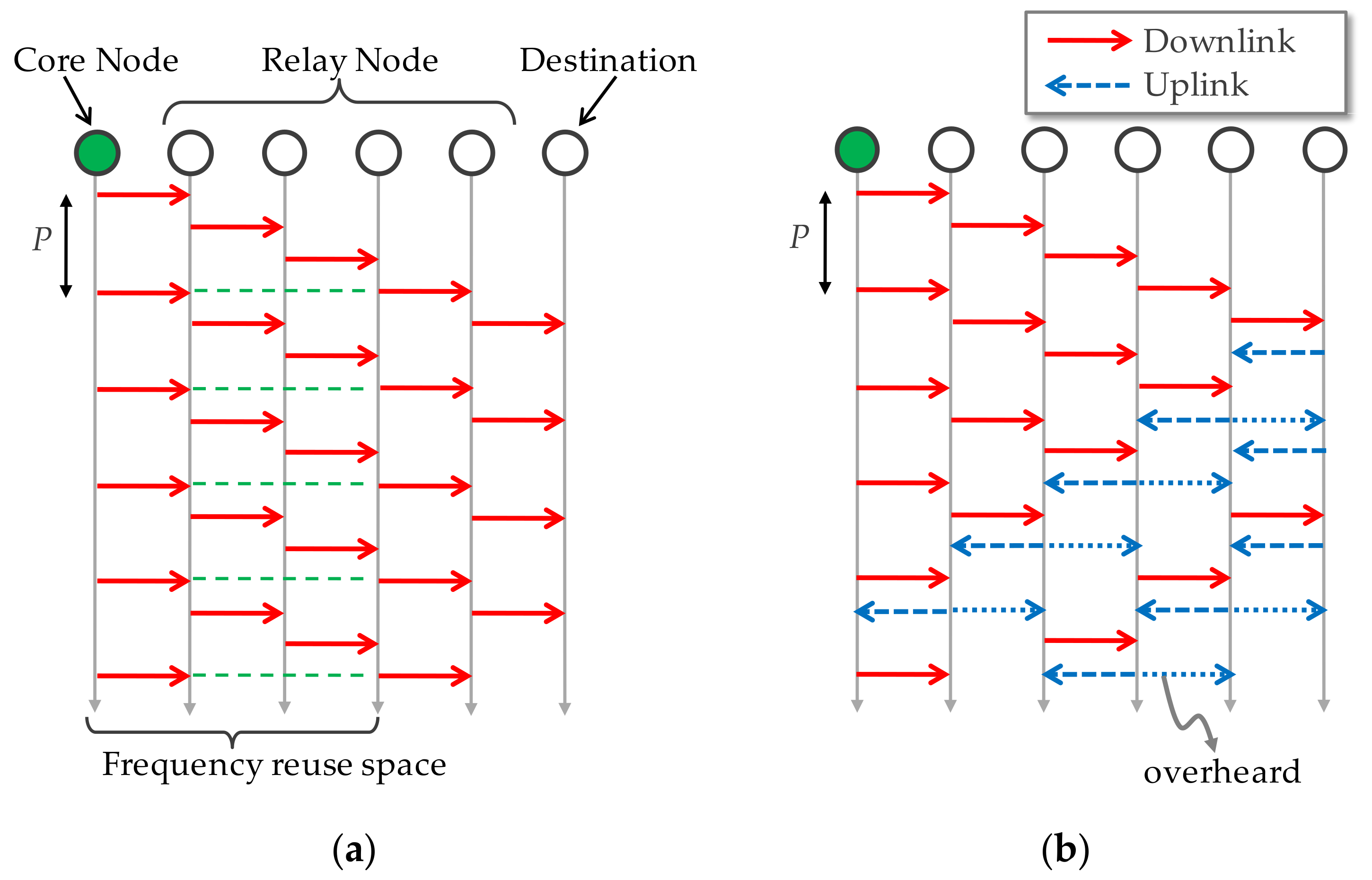
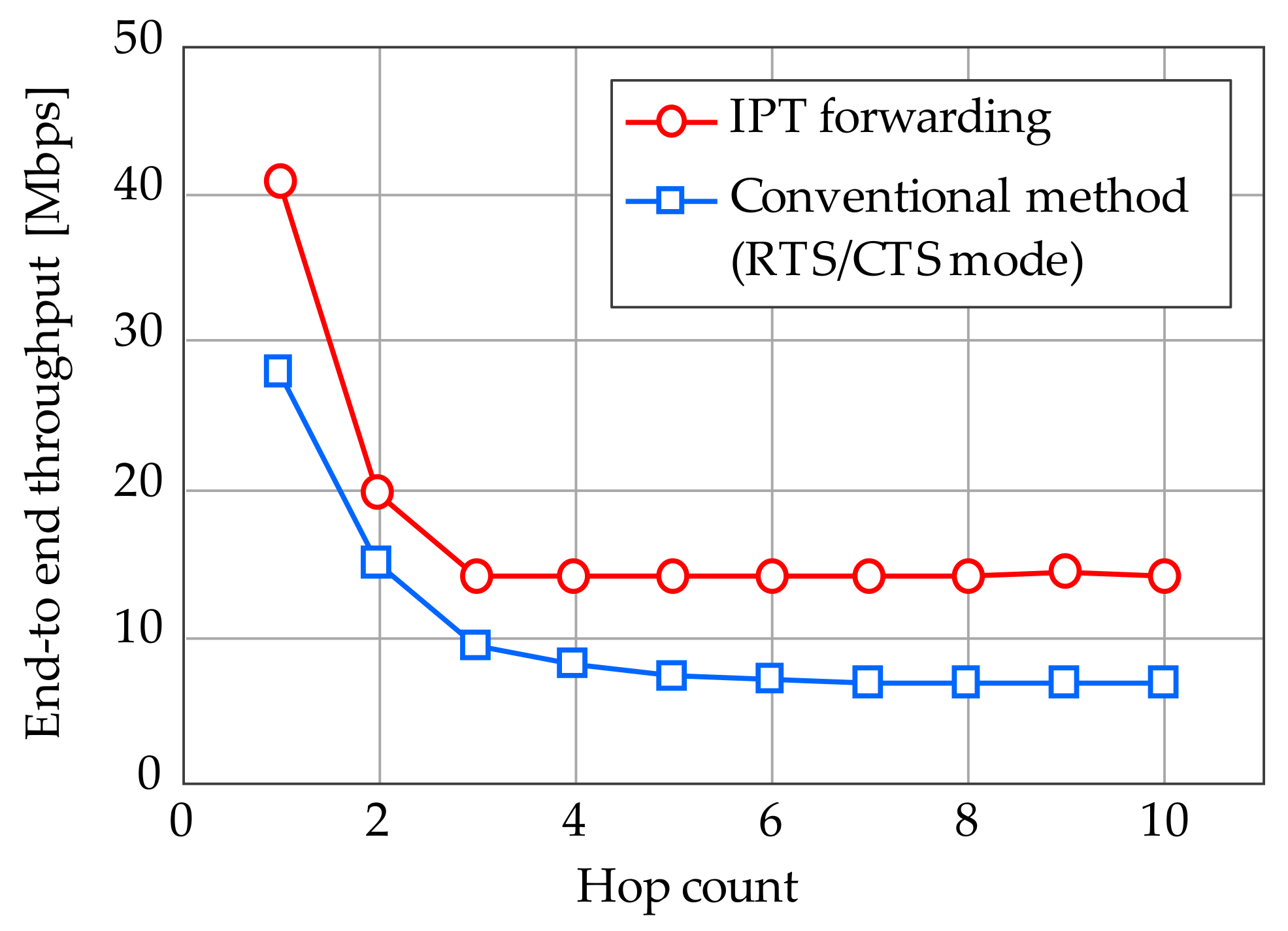


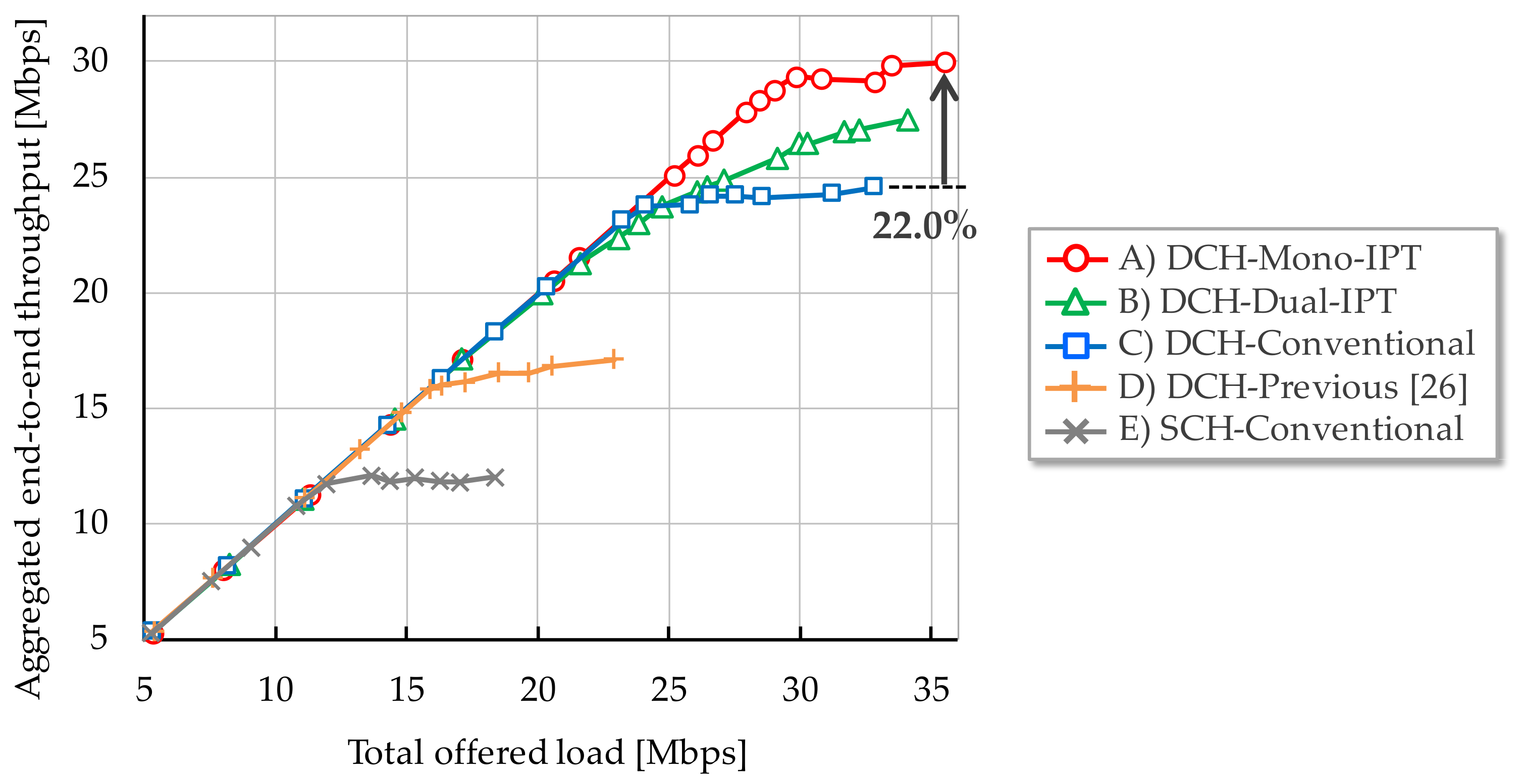
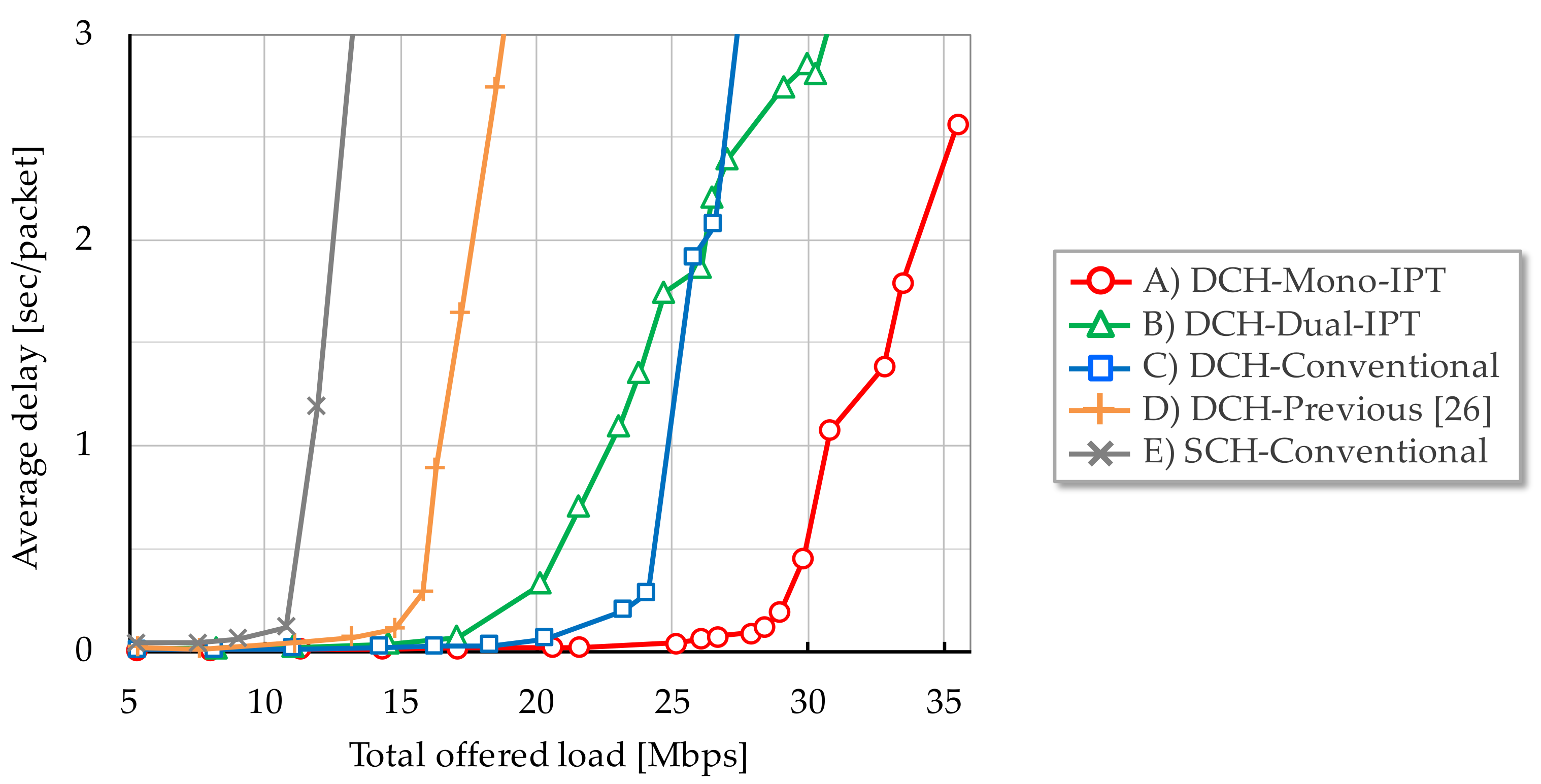


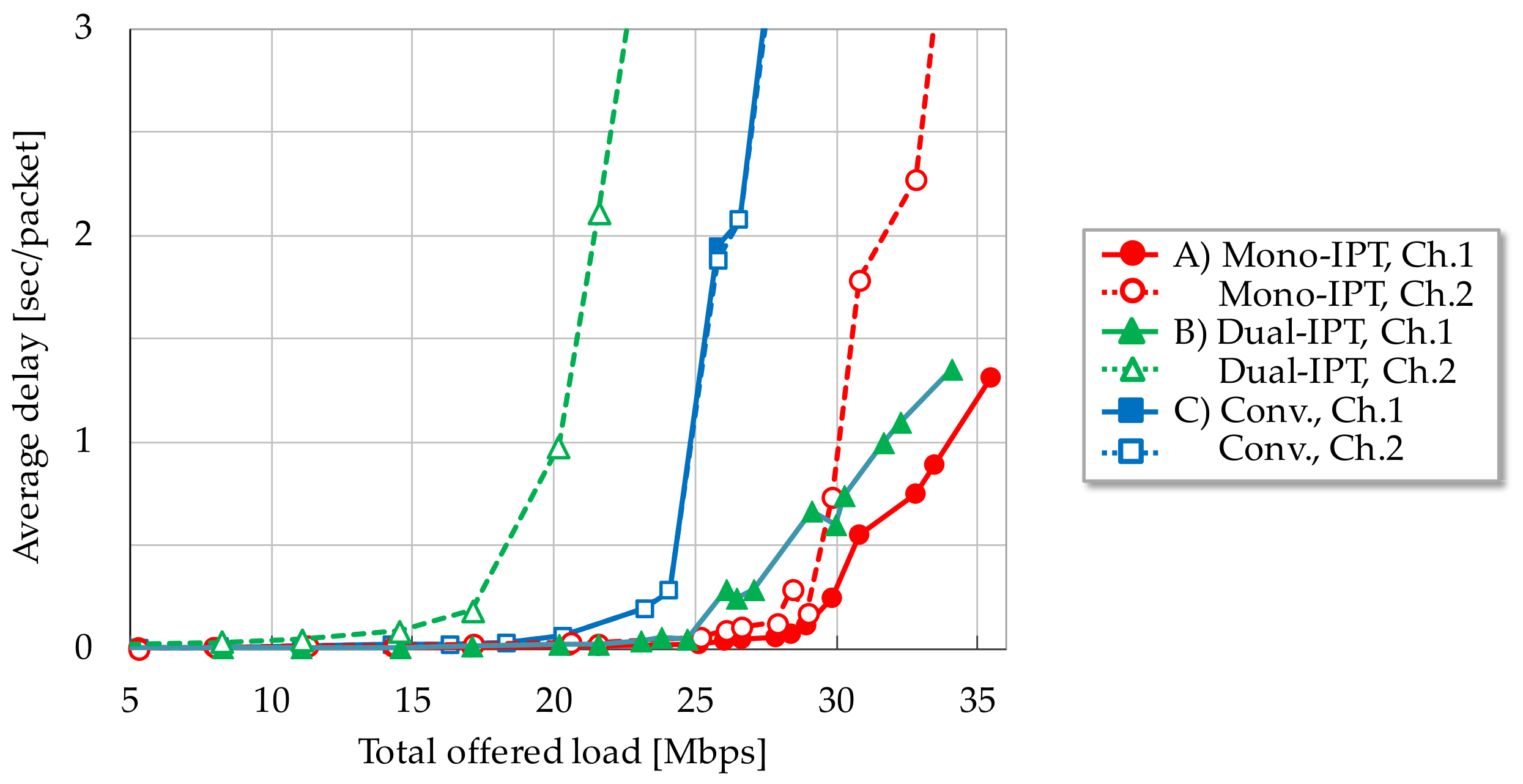
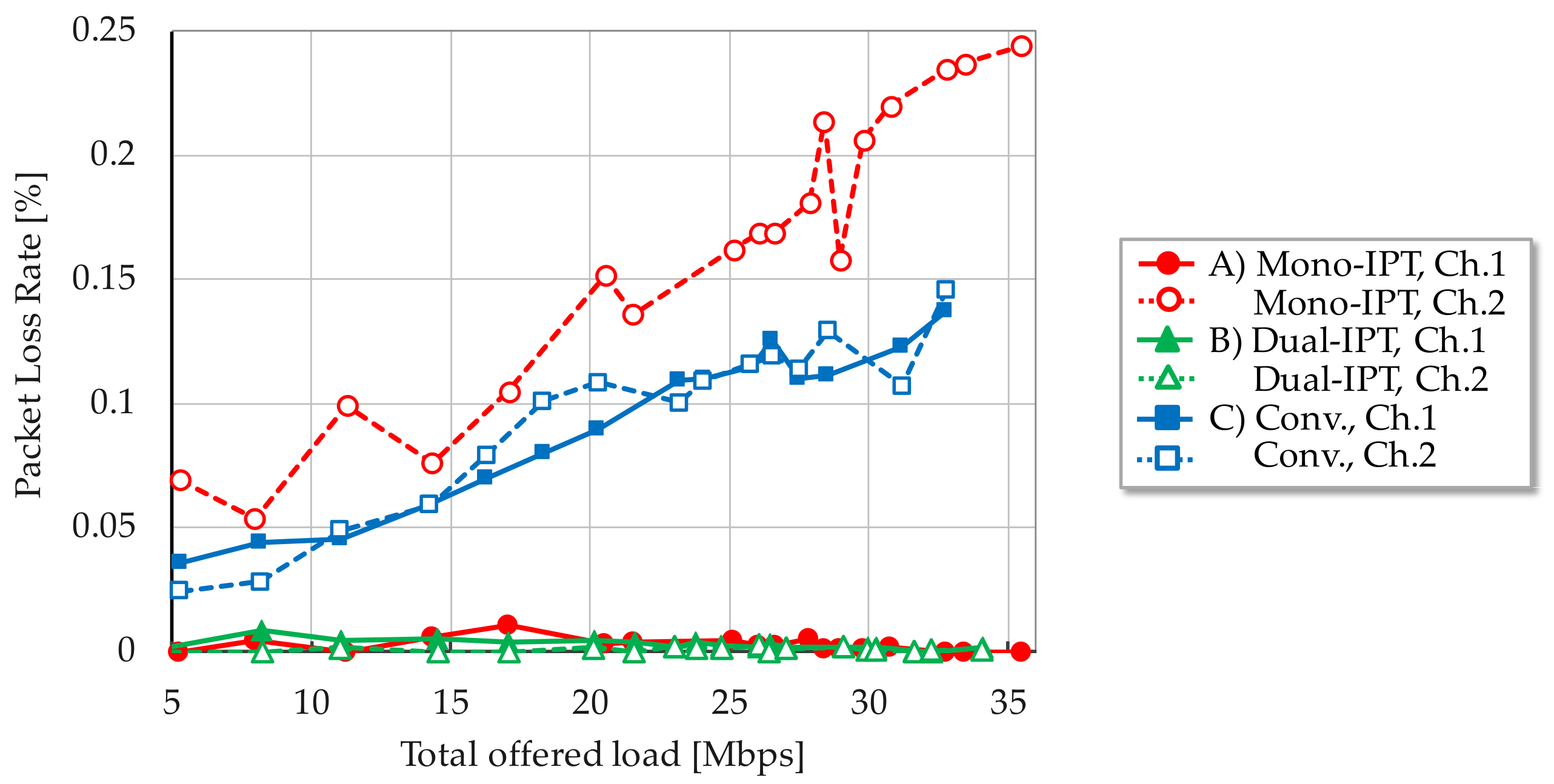
| Parameters | (A) DCH-Mono-IPT | (B) DCH-Dual-IPT | (C) DCH-Conv. | (D) DCH-Previous | (E) SCH-Conv. | ||||
|---|---|---|---|---|---|---|---|---|---|
| Ch.1 | Ch.2 | Ch.1 | Ch.2 | Ch.1 | Ch.2 | Ch.1 | Ch.2 | Ch.1 | |
| Wireless IF | IEEE 802.11a [47] | ||||||||
| Tx rate | 54 Mbps | ||||||||
| Channel model | IEEE 802.11 TGn channel model D [48] | ||||||||
| Wall penetration loss: 12 dB [49] | |||||||||
| Routing protocol | Minimum path loss routing [46] | ||||||||
| Traffic model | Poisson origination, Log-normal distribution | ||||||||
| Avg. DL: 20 packets, UL: 3 packets [50] | |||||||||
| Packet size: 1500 bytes, | |||||||||
| Offered load ratio DL:UL=10:1 [51] | |||||||||
| Relay scheme | IPT | CSMA/CA | IPT | Bi-IPT | CSMA/CA | IPT | CSMA/CA | CSMA/CA | |
| RTS/CTS | Off | On | Off | Off | On | Off | On | On | |
| MinCW (slot) | 7 | 15 | 7 | 7 | 15 | 7 | 15 | 15 | |
| Buffering | Round Robin | FIFO | Round Robin | Round Robin | FIFO | Round Robin | FIFO | FIFO | |
| Traffic handling | DL | DL+UL | DL | DL+UL | DL+UL | DL | UL | DL+UL | |
| Ch. switching threshold | 100 packets | 100 packets | 100 packets | 100 packets | |||||
| Tx period (μsec) | 0, 100 | 0 | 0, 100 | 100, 700 | 0 | 0, 100 | 0 | 0 | |
© 2017 by the authors. Licensee MDPI, Basel, Switzerland. This article is an open access article distributed under the terms and conditions of the Creative Commons Attribution (CC BY) license (http://creativecommons.org/licenses/by/4.0/).
Share and Cite
Maruta, K.; Furukawa, H. Highly Efficient Multi Channel Packet Forwarding with Round Robin Intermittent Periodic Transmit for Multihop Wireless Backhaul Networks. Sensors 2017, 17, 2609. https://doi.org/10.3390/s17112609
Maruta K, Furukawa H. Highly Efficient Multi Channel Packet Forwarding with Round Robin Intermittent Periodic Transmit for Multihop Wireless Backhaul Networks. Sensors. 2017; 17(11):2609. https://doi.org/10.3390/s17112609
Chicago/Turabian StyleMaruta, Kazuki, and Hiroshi Furukawa. 2017. "Highly Efficient Multi Channel Packet Forwarding with Round Robin Intermittent Periodic Transmit for Multihop Wireless Backhaul Networks" Sensors 17, no. 11: 2609. https://doi.org/10.3390/s17112609
APA StyleMaruta, K., & Furukawa, H. (2017). Highly Efficient Multi Channel Packet Forwarding with Round Robin Intermittent Periodic Transmit for Multihop Wireless Backhaul Networks. Sensors, 17(11), 2609. https://doi.org/10.3390/s17112609





